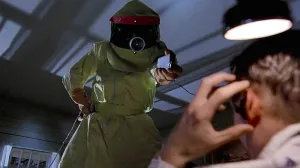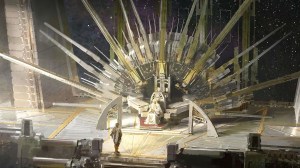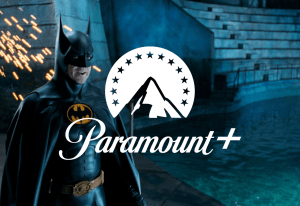While Batman’s lore is filled with some of the most feared and violent criminal organizations in the DC Universe, not all of them are created equal. The Court of Owls, for example, is a relatively new addition to Batman’s rogues’ gallery, but they’ve quickly become one of the most terrifying cabals in DC history. Their fearsome reputation stems from how deeply they are embedded — almost “infested” — within Gotham’s social and political fabric, as well as their deadly enforcers known as the Talons. Together, these elements give the Court of Owls an unmatched ability to make offers that no one in Gotham, regardless of status or influence, can afford to refuse.
Videos by ComicBook.com
As terrifying as the Court of Owls is, Gotham’s Future State gives rise to The Magistrate — an even more oppressively powerful group that has become the most fearsome force Gotham City has ever faced.
Security in Gotham City Grows From the Fist of A Magistrate’s Peacemaker

Under the authority of Gotham City Mayor Nakano the Magistrate was granted immense power to operate as it sees fit, effectively putting it above the law. This authority is contingent only on the company’s actions having a direct link to stopping masked vigilantes, costumed heroes, or villains within city limits. The Magistrate is, in essence, a hybrid private security agency contracted by Gotham City to initially administer its security services, covering all masked vigilantes and anyone defined as a superhero or supervillain.
Crucially, the Magistrate is not bound by the city’s directives or obligated to act in its best interest. Instead, the Magistrate operates solely according to the whims of its owner-director, Simon Saint, or his representatives. But the Magistrate isn’t just any private security firm. Rather, it’s a terrifying synthesis of the worst aspects of history’s most heinous secret police forces and extra-judicial death squads.
Since its effectiveness relies on leveraging advanced technologies in pursuit of security, Mayor Nakano gave the Magistrate carte blanche to deploy mass surveillance technologies, psychological digital warfare, and repression to control and demoralize citizen opposition to its rule. Additionally, the Magistrate’s original “behind the lines” security posture has shifted to an affirmatively aggressive paramilitary ideology, allowing it to “shoot first and ask questions later.” With complete authority to act without city oversight, the Magistrate has effectively taken control of the city’s administration.
The Magistrate Redefines the Concept of an Information Society

What makes the Magistrate even more terrifying than the Court of Owls is its overt, “in-your-face” approach and its threat of total and immediate punishment. Unlike the shadowy secrecy of the Court, the Magistrate is unapologetic about its purpose: you either “bend a knee” to their anti-vigilante laws or face the full weight of their unforgiving power. Put simply, the Magistrate’s brand of terror is open and notorious. Citizens are under no illusions about the consequences of resistance. The organization has no qualms about employing brutal, public punishments, and its forces face no restrictions when it comes to using lethal force in response to any perceived violation of the law.
Still, while the Magistrate’s power is undeniably formidable, it appears less comprehensive than that of the Court of Owls—at least on the surface. Unlike the Magistrate, the Court has no interest in openly flexing its power. Its operations begin and end in the shadows, embedded within the fringes of Gotham City’s elite and underworld alike. As a result, unless you become a target of their attention, most citizens remain unaware of the Court’s existence, aside from rumors and urban legends. Structured in this way, the Court of Owls presents a significant challenge to the Magistrate. So long as its members remain silent and masked, the Magistrate has little means of detecting, let alone dismantling, the Court’s covert influence.
The Magistrate has Rendered Oppression Down to A Science

This perspective, however, overlooks an important factor in how the Magistrate initially rose to power — one that proves they are the most terrifying group Gotham City has ever encountered. While much of their fear factor stems from their overt and oppressive use of force, they also operate an alarmingly effective shadow network. As detailed in Batman (2016) #112, one of the primary reasons Mayor Nakano ultimately approved the Magistrate’s power grab was the behind-the-scenes manipulation of its owner-director, Simon Saint. In James Tynion IV and Riccardo Federici’s Batman: Fear State Alpha #1 Saint, exploiting the fear generated by the Joker’s war on Gotham, colludes with the Scarecrow to amplify the city’s paranoia to such an extent that officials felt they had no choice but to deploy the Magistrate, and steadily surrender more authority to them.
It is this terrifying duality —a hidden power that remains invisible until you become its target, combined with an overwhelming overt authority that enforces constant surveillance, brutal intimidation, and summary punishment— that makes the Magistrate such a fearsome entity. By eliminating the ability of people to openly challenge its authority and instilling enough fear through its covert operations to prevent even private discussions of dissent, the Magistrate suffocates opposition at every level. In doing so, it perfects its oppression and renders its rule nearly absolute. If you doubt its power, ask Batman what he thinks of the Magistrate – that is, if you can find him.









